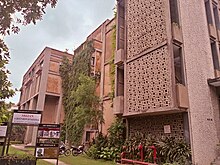Triveni Kala Sangam

Triveni Kala Sangam entrance with auditorium building
|
|
| Abbreviation | Triveni |
|---|---|
| Formation | 1950 |
| Founder | Sundari K. Shridharani |
| Purpose | Music, dance and arts education |
| Headquarters | 205 Tansen Marg, near Bengali Market, New Delhi-110001 |
Triveni Kala Sangam is an important cultural and arts complex and education centre in New Delhi. Founded in 1950, by Sundari K. Shridharani, who was also its Founding Director, Triveni, as it is commonly referred, contains four art galleries, a chamber theatre, outdoor theatre, open air sculpture gallery, besides this it runs its various arts, music and dance classes. It is situated on Tansen Marg, between Mandi House roundabout and Bengali Market.
The idea of starting a dance institution in Delhi was raised by Sundari K. Shridharani, a former student of dancer Uday Shankar, in 1950 when she had just moved to Delhi after marriage. The name 'Triveni Kala Sangam' was coined by flautist, Vijay Raghav Rao and literally meaning "confluence of arts". It started in one room above a Coffee House in Connaught Place, Delhi, with two students under noted artist K. S. Kulkarni. Soon her efforts got noticed, and Pandit Nehru allotted her the land for the institution. Gradually, she organized a small group of people, started organizing concerts, and collecting funds. Guru Rajkumar Singhajit Singh joined Triveni in 1954, as Head of the Manipur Dance Section, and later in 1962, founded the ‘Triveni Ballet’ of which he was Director and Principal Dancer.
An American architect was commissioned to design to multi-purpose complex of art galleries, chamber theatre, library, photography darkroom, staff quarters, classrooms over just half an acre of land. Finally construction began around 1957 and eventually on March 3, 1963, the present building was inaugurated.
Triveni was one of the first buildings by noted American architect, Joseph Allen Stein (1957-1977) in India, who also designed several important building in New Delhi, like India International Centre and India Habitat Centre, Lodhi Road. Designed in modern architecture style, the complex is noted for its " multiple spaces for multiple purposes" and use of jali work (stone lattices), which was to become Stein's hallmark.
...
Wikipedia
